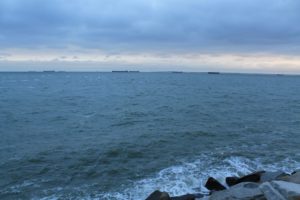Federal Cuts to Chesapeake Bay Programs Jeopardize Years of Progress

Maryland has made great progress in protecting the environment and ensuring that our natural resources continue to play an important part in our economy. Fracking is now banned, two offshore wind farms were recently approved, and the Chesapeake Bay is seeing healthy increases in oysters, female crabs, and sea grasses.
The progress that has been made in cleaning up Maryland’s vital waterways is now at risk, due to cuts proposed in President Trump’s budget. Along with cuts to many other geographic programs run by the Environmental Protection Agency, the entire $73 million annual allowance for the Chesapeake Bay Program is eliminated in the proposed budget. Maryland would directly lose $9 million from its state budget.
A healthy Chesapeake Bay is vital to Maryland’s economy, supporting tourism, commercial seafood, and real estate industries. The Maryland seafood industry alone contributes $600 million to the state economy each year. Decreases in the healthy populations of crabs and oysters have negative implications for businesses all the way down the supply chain, from those that harvest them to restaurants across the state that serve them. Even with all of the progress that has been made in the Bay in recent years, crabbers this year are still facing new restrictions on their harvest and the length of the season, due to a 50 percent drop in juvenile crabs compared to last year.
The Chesapeake Bay Program has been vital to restoration efforts for more than 30 years. It has bipartisan support and has proven effective in improving water quality and the overall health of the Bay and its watershed. The slow but steady progress the program has made is reliant on continued investment in cleanup and maintenance projects.
Restoring and preserving the health of the Chesapeake Bay watershed also lowers drinking water treatment costs. Clean waterways raise the value of nearby properties by up to 25 percent, and a healthy Chesapeake Bay contributes to the quality of life that Maryland can offer, which is vital to attracting a top-notch workforce that is appealing to businesses. Marriott International Inc. CEO, Arne Sorenson even cited the Chesapeake Bay as a factor in choosing to build a new $600 million headquarters in Bethesda.
If cleanup and maintenance programs continue to receive funding, it is estimated that a fully restored Chesapeake Bay will generate $20.4 billion per year in economic benefits for Maryland. However if cleanup efforts are discontinued, the Bay could instead lose $6 billion in value.
Because the Chesapeake Bay watershed spans six states – Maryland, Delaware, New York, Pennsylvania, Virginia, and West Virginia – and the District of Columbia, Maryland cannot clean up the Bay on its own. The Chesapeake Bay Program coordinates efforts in each part of the watershed and helps to keep each state accountable for doing its part to improve and preserve the Bay’s health. Additional cuts proposed in the budget to the EPA, U.S. Department of Agriculture, the Department of Interior, NOAA, the Army Corps of Engineers, and the U.S. Geological Survey will also have negative implications for the Bay. Cuts to NOAA include $1.5 million for the Maryland Sea Grant program, which supports 42 jobs in research and Bay cleanup projects.
Congress voted to secure funding for the Chesapeake Bay Program through September, but its future beyond then is uncertain. The President’s budget proposes to cut billions of dollars in federal funding to Maryland over the next 10 years, and it is vital these funds are preserved.
